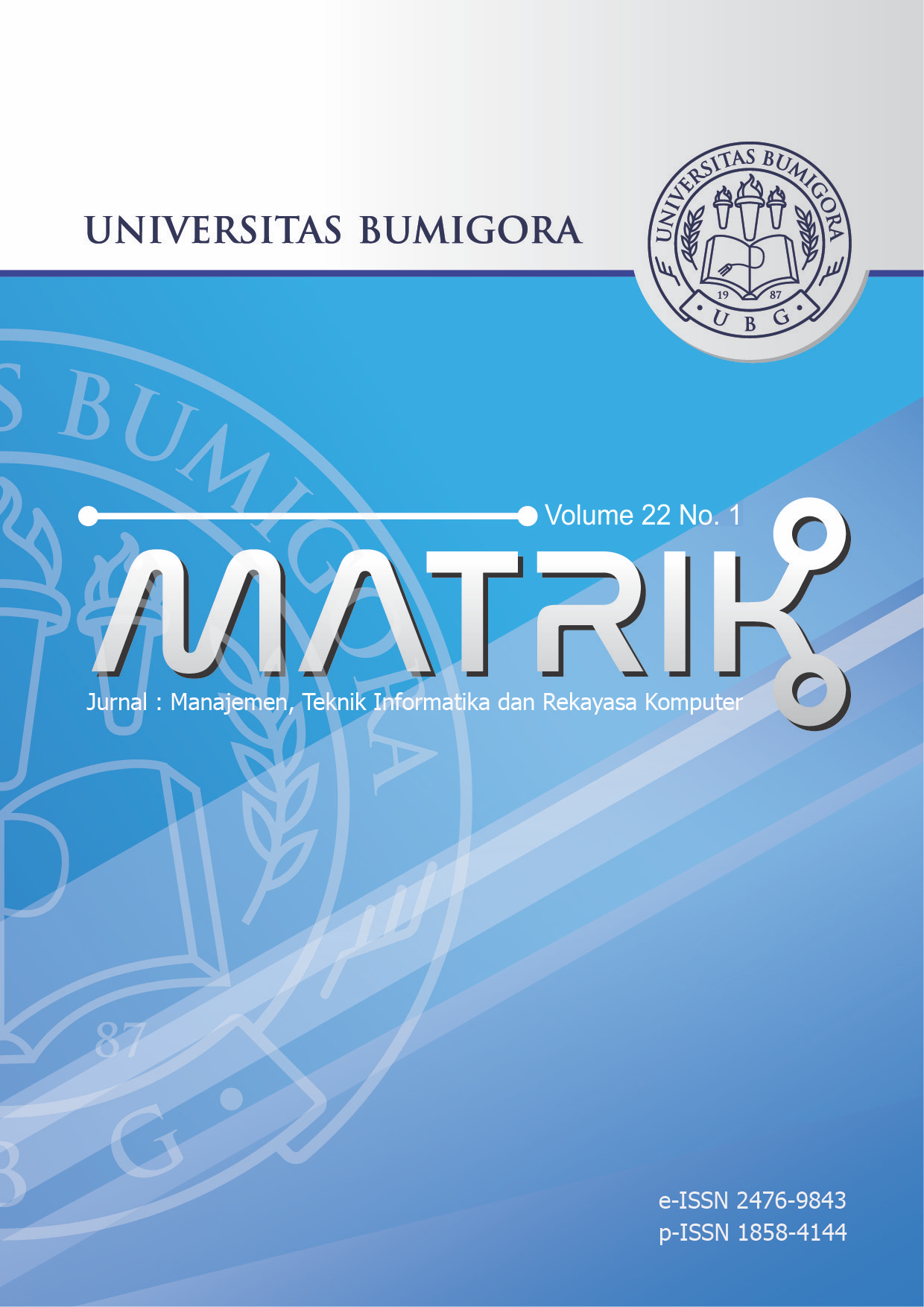The Improvement of Artificial Neural Network Accuracy Using Principle Component Analysis Approach
DOI:
https://doi.org/10.30812/matrik.v22i1.1880Keywords:
Mushroom Classification, Neural Network, Principle Component AnalysisAbstract
An important problem in a classification system is how to get good accuracy results. A way to increase the accuracy of a classifier system is to improve the number of input data attributes. Improving the number of input data attributes can be done using the Principal Component Analysis (PCA) method. The aim of this research is to reduce the number of input data attributes to increase the accuracy in a mushroom classification system. The research method used in this study started from collecting datasets from Kaggle.com related to mushroom-classification, then the data visualization process was carried out using pie charts then a dimension reduction process was carried out to reduce the number of variables using the PCA method. The next step is the training and testing of the artificial neural network. The architecture of artificial neural network used is backward error propagation with the number of hidden layers as much as 2 layers with the number of cells as many as 3 and 2. The training data used is 80%, while the testing data is 20%. Based on the test results, obtained an accuracy of 100% with 150,000 iterations and using 11 input variables from 22 existing input variables. By adding Principal Component Analysis part of the development that can improve the accuracy and performance of Artificial Neural Networks
Downloads
References
[2] I. P. Putra, “Note on Macro Fungi on Belitong Island: Description and Potential,†BIOEDUSCIENCE: Jurnal Pendidikan Biologi dan Sains, vol. 4, no. 1, pp. 11–20, 2020, doi: 10.29405/j.bes/4111-204416.
[3] I. P. Putra, “Studi Taksonomi dan Potensi Beberapa Jamur Liar di Pulau Belitong,†Justek : Jurnal Sains dan Teknologi, vol. 3, no. 1, pp. 24–31, 2020, doi: 10.31764/justek.v3i1.3534.
[4] I. P. Putra, “Kasus keracunan Inocybe sp. di Indonesia,†in Prosiding Seminar Nasional Biologi di Era Pandemi COVID-19, 2020, pp. 148–153.
[5] E. I. Haksoro and A. Setiawan, “Pengenalan Jamur yang Dapat Dikonsumsi Menggunakan Metode Transfer Learning pada Convolutional Neural Network,†Jurnal ELTIKOM : Jurnal Teknik Elektro, Teknologi Informasi dan Komputer, vol. 5, no. 2, pp. 81–91, May 2022, doi: 10.31961/eltikom.v5i2.428.
[6] R. Hayami, S. Soni, and I. Gunawan, “Klasifikasi Jamur Menggunakan Algoritma Naïve Bayes,†Jurnal CoSciTech (Computer Science and Information Technology), vol. 3, no. 1, pp. 28–33, 2022, doi: 10.37859/coscitech.v3i1.3685.
[7] I. P. Putra, “Kasus-Kasus Keracunan Jamur Liar di Indonesia,†Jurnal Ekologi Kesehatan, vol. 20, no. 3, pp. 215–230, Mar. 2022, doi: 10.22435/jek.v20i3.4943.
[8] S. K. Verma and M. Dutta, “Mushroom Classification Using ANN and ANFIS Algorithm,†IOSR Journal of Engineering (IOSRJEN), vol. 08, no. 01, pp. 94–100, 2018.
[9] J. U. Lidasan and M. P. Tagacay, “Mushroom Recognition using Neural Network,†IJCSI International Journal of Computer Science Issues, vol. 15, no. 5, pp. 52–57, 2018.
[10] E. S. Alkronz, K. A. Moghayer, M. Meimeh, M. Gazzaz, B. S. Abu-Nasser, and S. S. Abu-Naser, “Prediction of Whether Mushroom is Edible or Poisonous Using Back-propagation Neural Network,†International Journal of Academic and Applied Research, vol. 3, no. 2, pp. 1–8, 2019, [Online]. Available: http://www.ijeais.org/ijaar.
[11] R. Hanseliani, “Klasifikasi Berbagai Jenis Jamur Layak Konsumsi Dengan Metode Backpropagation,†Universitas Sanata Dharma, 2019.
[12] O. N. Putri, “Implementasi Metode CNN Dalam Klasifikasi Gambar Jamur Pada Analisis Image Processing (Studi Kasus: Gambar Jamur Dengan Genus Agaricus Dan Amanita),†Universitas Islam Indonesia, 2020.
[13] S. Enggari, A. Ramadhanu, and H. Marfalino, “Peningkatan Digital Image Processing Dalam Mendeskripsikan Tumbuhan Jamur Dengan Segmentasi Warna, Deteksi Tepi Dan Kontur,†Jurnal Teknologi Dan Sistem Informasi Bisnis, vol. 4, no. 1, pp. 70–75, 2022, doi: 10.47233/jteksis.v4i1.358.
[14] E. Tanuwijaya and A. Roseanne, “Modifikasi Arsitektur VGG16 untuk Klasifikasi Citra Digital Rempah-Rempah Indonesia,†MATRIK : Jurnal Manajemen, Teknik Informatika dan Rekayasa Komputer, vol. 21, no. 1, pp. 189–196, Nov. 2021, doi: https://doi.org/10.30812/matrik.v21i1.1492.
[15] A. S. Ritonga and I. Muhandhis, “Teknik Data Mining Untuk Mengklasifikasikan Data Ulasan Destinasi Wisata Menggunakan Reduksi Data Principal Component Analysis (PCA),†Jurnal Ilmiah Edutic, vol. 7, no. 2, pp. 124–133, 2021.
[16] A. L. Unihehu and I. Suharjo, “The Klasifikasi Jenis Ikan Berbasis Jaringan Saraf Tiruan Menggunakan Algoritma Principal Component Analysis (PCA),†Jurnal Ilmiah Ilmu Komputer, vol. 7, no. 2, pp. 27–32, 2021, doi: 10.35329/jiik.v7i2.200.
[17] H. Harizahayu, “Pengenalan Ekspresi Raut Wajah Berbasis Jaringan Saraf Tiruan Backpropagation Dengan Metode Principal Component Analysis,†BAREKENG: Jurnal Ilmu Matematika dan Terapan, vol. 15, no. 1, pp. 037–046, Mar. 2021, doi: 10.30598/barekengvol15iss1pp037-046.
[18] D. Frenza and R. Mukhaiyar, “Aplikasi Pengenalan Wajah dengan Metode Adaptive Resonance Theory (ART),†Ranah Research : Journal of Multidisciplinary Research and Development, vol. 3, no. 3, pp. 35–42, 2021, [Online]. Available: https://jurnal.ranahresearch.com/index.php/R2J/article/view/392.
[19] A. Hermawan and D. Avianto, “The Implementation of Neural Network On Determining the Determinant Factors Towards Students’ Stress Resistance,†Journal of Telecommunication, Electronic and Computer Engineering (JTEC), vol. 9, no. 3, pp. 129–133, Sep. 2017, [Online]. Available: https://jtec.utem.edu.my/jtec/article/view/1527.
[20] K. A. Widagdo, K. Adi, and R. Gernowo, “Kombinasi Feature Selection Fisher Score dan Principal Component Analysis (PCA) untuk Klasifikasi Cervix Dysplasia,†Jurnal Teknologi Informasi dan Ilmu Komputer, vol. 7, no. 3, pp. 565–572, 2020, doi: 10.25126/jtiik.2020702987.
Downloads
Published
Issue
Section
How to Cite
Similar Articles
- Magdalena Ariance Ineke Pakereng, Alz Danny Wowor, Yos Richard Beeh, Felix David, Erwien Christianto, Vincent Exelcio Susanto, Claudio Canavaro, Square Transposition Method with Adaptive Key Flexibility and Strong Diffusion Performance , MATRIK : Jurnal Manajemen, Teknik Informatika dan Rekayasa Komputer: Vol. 24 No. 3 (2025)
- Achmad Rian Tarmizi, Ahmat Adil, Lilik Widyawati, Optimization of The use of Wireless Lan Devices to Minimize Operational Costs , MATRIK : Jurnal Manajemen, Teknik Informatika dan Rekayasa Komputer: Vol. 19 No. 2 (2020)
- Siti Ummi Masruroh, Cong Dai Nguyen, Doni Febrianus, Comparative Analysis of TF-IDF and Modern Text Embedding for the Classification of Islamic Ideologies on Indonesian Twitter , MATRIK : Jurnal Manajemen, Teknik Informatika dan Rekayasa Komputer: Vol. 25 No. 1 (2025)
- Frans Mikael Sinaga, Sio Jurnalis Pipin, Sunaryo Winardi, Karina Mannita Tarigan, Ananda Putra Brahmana, Analyzing Sentiment with Self-Organizing Map and Long Short-Term Memory Algorithms , MATRIK : Jurnal Manajemen, Teknik Informatika dan Rekayasa Komputer: Vol. 23 No. 1 (2023)
- Angelina Ervina Jeanette Egeten, Lya Santi Rahayu, Riansyah Rafsanjani, Analisis dan Perancangan Sistem Reservasi Paket Wisata Untuk Internal Karyawan PT. Garuda Maintenance Facility (GMF) Tbk , MATRIK : Jurnal Manajemen, Teknik Informatika dan Rekayasa Komputer: Vol. 19 No. 1 (2019)
- Angelina Ervina Jeanette Egeten, Siska A. Damanik, Ika Agustina, Marcelina Panggabean, Perancangan Sistem Informasi Posyandu Berbasis Web Pada Yayasan Kalyanamitra Di Jakarta Timur Untuk Mendukung Program Bidang Pendampingan Komunitas , MATRIK : Jurnal Manajemen, Teknik Informatika dan Rekayasa Komputer: Vol. 18 No. 2 (2019)
- Ahmad Zein Al Wafi, Febry Putra Rochim, Veda Bezaleel, Investigating Liver Disease Machine Learning Prediction Performancethrough Various Feature Selection Methods , MATRIK : Jurnal Manajemen, Teknik Informatika dan Rekayasa Komputer: Vol. 24 No. 3 (2025)
- Siti Ummi Masruroh, Andrew Fiade, Muhammad Ikhsan Tanggok, Rizka Amalia Putri, Luigi Ajeng Pratiwi, Convolutional Neural Network for Colorization of Black and White Photos , MATRIK : Jurnal Manajemen, Teknik Informatika dan Rekayasa Komputer: Vol. 22 No. 2 (2023)
- Debby Ummul Hidayah, Pungkas Subarkah, Media Pembelajaran Tentang Klasifikasi Binatang Berbasis Video Animasi 3 Dimensi di SMP Negeri 2 Wangon , MATRIK : Jurnal Manajemen, Teknik Informatika dan Rekayasa Komputer: Vol. 19 No. 1 (2019)
- Raisul Azhar, ANALISA PERBANDINGAN PENERAPAN PBR DAN NON PBR PADA PROTOCOL OSPF UNTUK KONEKSI INTERNET , MATRIK : Jurnal Manajemen, Teknik Informatika dan Rekayasa Komputer: Vol. 15 No. 1 (2015)
You may also start an advanced similarity search for this article.
Most read articles by the same author(s)
- Aditya Dwi Putro, Arief Hermawan, Pengaruh Cahaya dan Kualitas Citra dalam Klasifikasi Kematangan Pisang Cavendish Berdasarkan Ciri Warna Menggunakan Artificial Neural Network , MATRIK : Jurnal Manajemen, Teknik Informatika dan Rekayasa Komputer: Vol. 21 No. 1 (2021)
- Muhammad Rizki, Arief Hermawan, Donny Avianto, Learning Accuracy with Particle Swarm Optimization for Music Genre Classification Using Recurrent Neural Networks , MATRIK : Jurnal Manajemen, Teknik Informatika dan Rekayasa Komputer: Vol. 23 No. 2 (2024)


.png)












